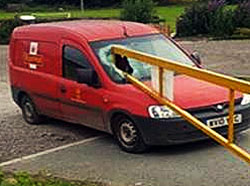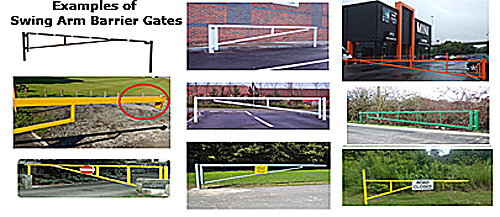Communication Workers Union (CWU) National Health and Safety Officer Dave Joyce has asked all CWU Safety Reps to ensure all members who drive as part of their job are aware of the dangers posed by unsecured ‘swing-arm barrier gates following a recent accident involving a Keighley Postman Delivery Driver who received serious head and facial injuries after a collision with one of these barrier gates that went through his windscreen.
In a previous accident in 2011, a 48 years old Somerset Postman Driver was killed when the swing arm barrier penetrated the Windscreen on his van and went through his chest killing him instantly.
 North Lincolnshire Council were recently fined £200,000 including costs after being prosecuted by the Health and Safety Executive (HSE) following the death of a car driver who died when his car drove into a swing arm barrier gate to a Council sports ground car park in August 2012.
North Lincolnshire Council were recently fined £200,000 including costs after being prosecuted by the Health and Safety Executive (HSE) following the death of a car driver who died when his car drove into a swing arm barrier gate to a Council sports ground car park in August 2012.
The HSE have warned that a significant number of people have been killed or injured in incidents involving horizontal swing arm barrier gates in car parks used in retail, leisure and industrial premises.
They’ve told duty holders to take suitable precautions including making sure swing barrier gates are locked open and shut to suitable fixing posts with a padlock so they cannot swing open and present an impalement risk to drivers and to companies like Royal Mail delivering to or collecting from companies and organisations. They’ve also suggested making sure the barriers are made visible by painting or marking them distinctly and ensuring barriers are maintained.
CWU National Health & Safety Officer Dave Joyce said:
“Accidents have occurred when barriers have been inadequately secured so that they have partially opened and presented a least visible end on profile of the protruding barrier which has impaled an oncoming vehicle. The end profile of the barrier may not be clearly visible to an oncoming driver. Other incidents have occurred as a barrier has swung into the path of an oncoming vehicle. Unsecured barriers can swing open due to the wind, gravity or as a result of vandalism.”
 The HSE has decided to produce information to remind users of these swing arm barrier gates of their legal health and safety duties in relation to the safe use of such barriers which are commonly found on the entrances to industrial estates, retail premises, leisure premises, sporting complexes, parks, farms etc - any premise with a car park entrance or exit to which members of the public and workers have vehicular access, can have these swing arm barrier gates.
The HSE has decided to produce information to remind users of these swing arm barrier gates of their legal health and safety duties in relation to the safe use of such barriers which are commonly found on the entrances to industrial estates, retail premises, leisure premises, sporting complexes, parks, farms etc - any premise with a car park entrance or exit to which members of the public and workers have vehicular access, can have these swing arm barrier gates.
Writing to all branches via Letter to Branches 605/16 (LTB605/16) Dave provided details of the newspaper report of the previous incident which resulted in the immediate death of Graham Wilkins as the swing barrier gate smashed through his van's windscreen and into his chest.
Dave, writing in LTB605/16 which was issued to all CWU Branches on 14th October and contains 7 attachments, gives brief details of the incidents and issues involved:
Serious Injuries Accident – Keighley:
On the 9th August this year a Keighley Delivery Office Postman and CWU member received serious injuries when his van collided with a ‘Swing Arm Barrier Gate’ which penetrated the Windscreen of his Royal Mail Vauxhall Combo Delivery Van and struck him in the face and head causing very serious injuries as he was leaving a sports centre premises after completing his deliveries to the premises. The member was fortunate to survive the accident and was hospitalised, undergoing major surgery and remains off work recovering and being treated for his injuries.
The CWU Health, Safety & Environment Department have held meetings and exchanged correspondence with both Bradford Council and the HSE to press for the owners of the premises to be prosecuted for Health and Safety Offences.
Fatal Accident - Somerset
 On June 24th 2011 a Somerset Delivery Office Postman and CWU member was killed in a similar crash into a swing arm barrier Gate, in an accident at a farm near Henstridge, in rural South Somerset.
On June 24th 2011 a Somerset Delivery Office Postman and CWU member was killed in a similar crash into a swing arm barrier Gate, in an accident at a farm near Henstridge, in rural South Somerset.
The member was fatally injured when his Royal Mail Ford Transit Connect delivery van crashed into a metal gate on his rural round.
The 48 years old member died from chest injuries after the Gate’s top metal bar punctured his Van’s windscreen and then went through his chest, causing a fatal wound.
The member was making a routine postal delivery to the premises on a round he had done regularly for six years. The unfortunate member was pronounced dead at the scene. There was no prosecution of the farm owners.
Fatal Accident Lincoln - North Lincolnshire Council Fined.
In a similar case, North Lincolnshire Council were prosecuted by the Health and Safety Executive (HSE) and were fined after a man died when his car drove into an unsecured swing arm barrier gate to a car park at a sports ground in August 2012. At Hull Crown Court North Lincolnshire Council was fined a total of £160,000, plus £40,476 costs after pleading guilty to an offence under Section 3(1) of the Health and Safety at Work etc. Act 1974.
HSE Warning and Advice.
The HSE have stated that a significant number of people have been killed or injured in incidents involving horizontal swing arm barrier gates in car parks used in retail, leisure and industrial premises. Duty holders should carry out a suitable risk assessment so that potential dangers are identified and suitable precautions are put in place. These include making sure such barriers can be locked open and shut to suitable fixing posts preferably with a padlock so they cannot swing open and present an impalement risk. In summary the HSE advice is:-
A barrier typically comprises of a horizontal bar or beam hinged at a vertical pillar. The bar is manually moved to open or close off access to an opening in a car park exit/entrance.
Accidents have occurred when barriers have been inadequately secured so that they have partially opened and presented a least visible end on profile of the protruding barrier which has impaled an oncoming vehicle. The end profile of the barrier may not be clearly visible to an oncoming driver. Other incidents have occurred as a barrier has swung into the path of an oncoming vehicle.
Unsecured barriers can swing open due to the wind, gravity, vibration or as a result of vandalism.
HSE has decided to produce this information to remind users of these swing arm barrier gates of their legal health and safety duties in relation to the safe use of such barriers.
Duty holders include persons in charge of the entrances to industrial estates, retail premises, leisure premises, sporting complexes, parks, farms etc. In short any premise with a car park entrance or exit to which members of the public and workers have vehicular access, may utilise such barriers.
Vertically opening or lifting barriers can also present safety risks if they are not correctly controlled.

Duty holders are reminded of their responsibilities in relation to barriers. They include:-
- Carrying out a suitable risk assessment so that potential dangers are identified and precautions are put in place to ensure they are removed or controlled.
- Reviewing existing risk assessments where horizontal swing barriers are in use to determine whether elimination of the risk is possible. Horizontal swing barriers rely on human intervention to ensure they are locked open or locked shut, they are also susceptible to vandalism which can leave them in an unsafe position. Vertical lifting gates are a lower risk alternative, as is the provision of lower height swing barriers so that any collision will result in damage to the vehicle without causing any part of the barrier to enter the vehicle with possible fatal consequences.
- Where horizontal barriers are used, making sure the barriers are adequately secured at all times whether open or shut (a padlock will suffice).
- Making sure the barriers are made visible by painting or marking with alternate red and white bands of adequate width to be clearly visible, so that persons do not inadvertently drive into them (additional local lighting may be required).
- Carrying out regular inspections to ensure that the methods of securing and visibility aspects have not deteriorated.
- Ensuring barriers are maintained in accordance with manufacturer’s instructions.
- Liaising with suppliers if your risk assessment reveals that securing and visibility requirements are inadequate.
LTB605/16 can be downloaded in full, including all 7 attachments, here
Source: CWU


 North Lincolnshire Council were recently fined £200,000 including costs after being prosecuted by the Health and Safety Executive (HSE) following the death of a car driver who died when his car drove into a swing arm barrier gate to a Council sports ground car park in August 2012.
North Lincolnshire Council were recently fined £200,000 including costs after being prosecuted by the Health and Safety Executive (HSE) following the death of a car driver who died when his car drove into a swing arm barrier gate to a Council sports ground car park in August 2012.  The HSE has decided to produce information to remind users of these swing arm barrier gates of their legal health and safety duties in relation to the safe use of such barriers which are commonly found on the entrances to industrial estates, retail premises, leisure premises, sporting complexes, parks, farms etc - any premise with a car park entrance or exit to which members of the public and workers have vehicular access, can have these swing arm barrier gates.
The HSE has decided to produce information to remind users of these swing arm barrier gates of their legal health and safety duties in relation to the safe use of such barriers which are commonly found on the entrances to industrial estates, retail premises, leisure premises, sporting complexes, parks, farms etc - any premise with a car park entrance or exit to which members of the public and workers have vehicular access, can have these swing arm barrier gates. On June 24th 2011 a Somerset Delivery Office Postman and CWU member was killed in a similar crash into a swing arm barrier Gate, in an accident at a farm near Henstridge, in rural South Somerset.
On June 24th 2011 a Somerset Delivery Office Postman and CWU member was killed in a similar crash into a swing arm barrier Gate, in an accident at a farm near Henstridge, in rural South Somerset. 